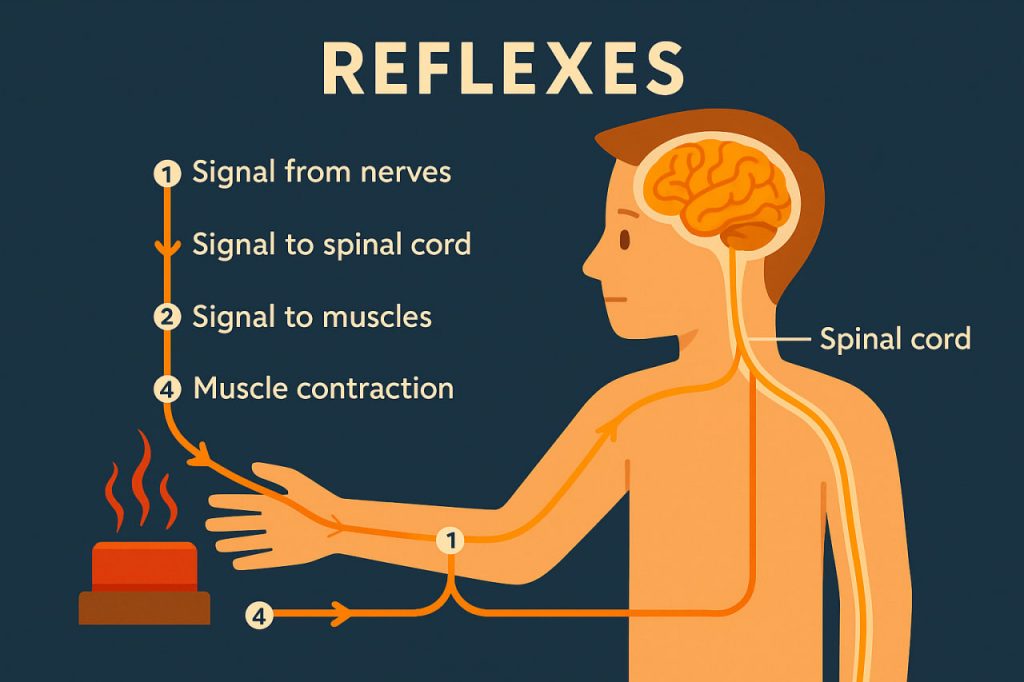Reflexes are among the most fascinating and vital functions of the human nervous system. They allow the body to react instantly to danger, discomfort, or unexpected stimuli — often before we even have time to think. Whether it’s jerking your hand away from a hot surface or blinking when something approaches your eyes, reflexes are automatic protective mechanisms that keep us safe and functioning efficiently.
What Are Reflexes?
A reflex is an involuntary, automatic response of the body to a specific stimulus. Unlike conscious actions, reflexes occur without direct involvement of the brain’s decision-making centers. Instead, they are processed through a reflex arc, a fast neural pathway that connects sensory input directly to motor output.
For example, when you touch something hot, sensory neurons in your skin send a signal to your spinal cord. The spinal cord instantly sends a message back to your muscles to pull your hand away — all in a fraction of a second. Only after this response does the signal reach your brain, which interprets the sensation as “pain.”
The Reflex Arc: How It Works
The reflex arc is the foundation of all reflex actions and involves five key components:
- Receptor: Detects the stimulus (such as heat or pressure).
- Sensory neuron: Transmits the signal to the spinal cord or brainstem.
- Integration center: Processes the information (usually within the spinal cord).
- Motor neuron: Sends the response signal to a muscle or gland.
- Effector: Carries out the reaction (for example, contracting a muscle).
This entire process happens in milliseconds, which is why reflexes are so effective for protection and survival.
Types of Reflexes
Reflexes can be divided into several categories based on their function and complexity:
- Simple (spinal) reflexes: Involve only the spinal cord, like the knee-jerk reflex tested by doctors.
- Complex reflexes: Involve both the spinal cord and brainstem, such as swallowing or coughing.
- Somatic reflexes: Control skeletal muscles (e.g., withdrawing from pain).
- Autonomic reflexes: Regulate internal organs, like heart rate or pupil dilation.
Examples of Human Reflexes
- Blink reflex: Protects the eyes from dust or sudden bright light.
- Cough reflex: Clears airways when irritants enter the throat.
- Pupil reflex: Adjusts pupil size based on light intensity.
- Babinski reflex: Seen in infants, where toes spread when the sole of the foot is stroked.
- Startle reflex: A quick response to loud sounds or sudden movement, preparing the body for action.
Reflexes in Survival and Evolution
Reflexes are essential for survival. They evolved to help humans and animals avoid harm and maintain balance in unpredictable environments. For example, reflexes like grasping and sucking in newborns are vital for feeding and bonding.
Even emotions can trigger reflex-like responses — such as an increased heartbeat during fear (the fight-or-flight response), controlled by the autonomic nervous system.
Reflex Training and Reaction Time
While reflexes are automatic, they can be strengthened and refined through training. Athletes, pilots, and surgeons rely on fast reflexes to respond precisely under pressure. Regular physical activity, coordination exercises, and sufficient sleep all help improve reaction time.
Reflexes and Health Diagnostics
Doctors often test reflexes to evaluate the health of the nervous system. Using a small hammer, they tap the knee or ankle to observe muscle responses. Abnormal or delayed reflexes can indicate neurological disorders, nerve damage, or spinal cord injuries.
Interesting Facts
- The fastest human reflex — the eye blink — takes about 0.1 seconds.
- Babies are born with more reflexes than adults, many of which disappear as the brain develops.
- Some reflexes, like sneezing or yawning, are contagious due to mirror neuron activity.
- In extreme danger, reflex actions can override conscious thought entirely, helping save lives.
Glossary
- Reflex arc — the neural pathway that enables a reflex action.
- Autonomic nervous system — the part of the nervous system controlling involuntary functions like heart rate.
- Effector — a muscle or gland that performs the reflex response.
- Fight-or-flight response — an automatic reaction to stress that prepares the body for quick action.
- Neurological reflex test — a medical exam that checks nerve and spinal cord function through reflex responses.


